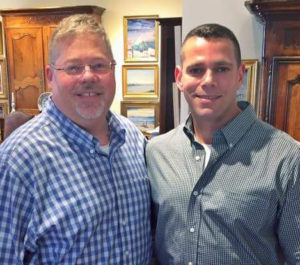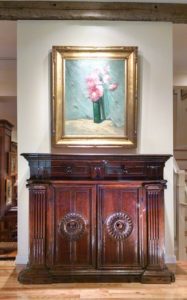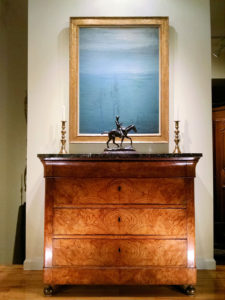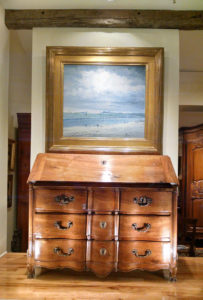8 Things To Know When Shopping For Antiques
I’d never gone antiquing until a few weeks ago. On a sunny Sunday, my daughter and I wandered into an antique shop on a lark. (It was near the farmers’ market and we loooove a farmers’ market.)
We met these guys:

They’re Paul Gallagher and Ronald Knox, owners of Stillwell House Fine Art & Antiques in Red Bank. They greeted us with contagious enthusiasm. These are not just history buffs; they are history aficionados.1. 1.
Here’s what happened: they reminded us that history is fascinating. Not school history where dates must be memorized and battles analyzed (though if that’s your thing, more power to you), but the kind of history you can find in an antique shop: tangible pieces of the past, items that were used every day by actual people, some of whom lived in actual castles. (Very cool.)
We were newcomers to the world of antiques. Here’s what they taught us.
1. “Vintage” and “Antique” mean different things
If an item is less than 100 years old, Paul and Ron call it vintage. True antiques have passed the century mark.
2. Antiques are harder to come by than they used to be.
One of the oldest pieces in Gallagher and Knox’s shop is this one:

Photo courtesy of Stillwell House Fine Art & Antiques
It’s an early Renaissance credenza circa 1525. It comes from the Palazzo Davanzati in Florence. “It came to the U.S. in the early 1900s,” Paul told us. “Nowadays most countries won’t let palace pieces like this one out.” (The painting is a 1916 watercolor by Leon Dabo.)
3. But antiques from the United States are a bit easier to find.
“A lot of the most beautiful pieces are here already,” noted Ron.

Photo courtesy of Stillwell House Fine Art & Antiques
The painting above this early 1800s chest of drawers is “Evening North Shore” circa 1913 by American painter Leon Dabo capturing the North Shore of Long Island.
4. High-quality antiques can be pricey, but they can be worth it.
Paul said, “Good quality antiques hold their value after use v. new-bought things.” Ron explained, “It’s about craftsmanship. Compare an armoire from the 1700s made by hand with a chisel to something mass-produced. It’s hard to argue about the quality. You’re buying a solid piece of wood. Somebody cut down a tree.”

Photo courtesy of Stillwell House Fine Art & Antiques
This scriban slant drop-front desk is French, Louis XV, circa 1750. Similar desks have sold for up to $24,000.00 (The painting is “Cote Normande” by Leon Dabo, 1938.)
5. But not all high-quality antiques are super expensive.
While some items can cost a small fortune, many are reasonably priced if you factor in their potential as an investment. “Not everything with value has to be extremely costly, ” Paul said. To illustrate, he showed us a botanical painting. “In 2003, it cost $800, 20 years later it’s $35,000. When your great-grandchildren get it, it could be worth hundreds of thousands of dollars. That’s possible with a great painting and a well-listed artist.” (I could almost hear my future great-grandchildren begging me to buy the painting. Shush, kids! Great-grandma’s thinking.)
6. Antiques can be paired with modern decor.
“Many top interior designers combine fine quality antique pieces with modern art. That’s what we’ve been doing here since our inception 15 years ago,” Paul explained. “We’ve always liked that look.”
7. It’s important to distinguish shady from solid.
It can be hard to tell if you’re getting a good deal, warned Ron. “It’s not like customers can go out and find 10 other examples of an item.” Paul and Ron recommend finding a reputable shop, and not just for obvious reasons. As Ron explained, “Some people like to buy antiques at traveling auctions. That’s sketchy. Because if you have a problem—if something turns out to be misrepresented—you don’t have a way to go back to that person.” Even when considering a purchase from an antique shop, Ron suggested that buyers “look online to see if a shop has any reviews or complaints. You’re trying to find out what you can about their reputation.”
8. And it’s even better to work with people who deeply care about antiques.
Before we left that day, Ron animatedly explained what had been immediately apparent to us as soon we entered the store. “We’re not just a cold, aloof antique shop. We try to provide an immersive experience because, at the end of the day, if people don’t have a connection with these objects, then it’s all just a bunch of stuff.”
Paul added his feelings about why antiques can be part of a life well lived. “If people are a product of their environment, and they have these inspirational pieces around, that can give them a boost.” Ron concluded, “Owning antiques is preserving a piece of history, and that is a noble endeavor with its own reward.”
Our takeaway? Antiques are about all of us. Preserving these pieces of history can make us feel like a part of all the generations that came before. And that’s a pleasant way to spend a sunny Sunday.
